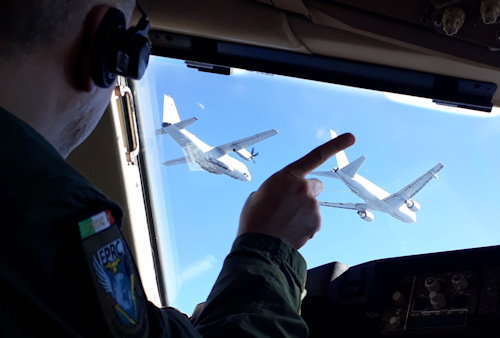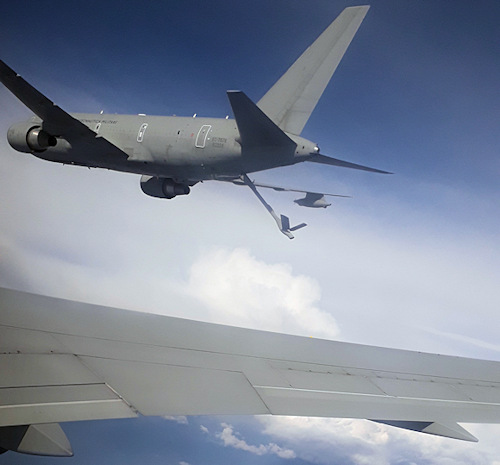Already when you are on the ladders and observe the aircraft, in the parking area of "De Bernardis" Airport of Pratica di Mare, you understand that what you are about to do will not be an ordinary flight. The Boeing KC-767A, included in the 14 ° Stormo dell'Aeronautica Militare, unlike the civil version 767-200ER (Extended Range) has only one porthole and there are no hostesses ready to welcome you on board. Even when you enter, you can sense the diversity of an airliner: spaces are narrower and to get to the passenger area, in this version called COMBI, you have to go through a door that gives access to the cargo area, where a small and narrow walkway is set up leading to the entrance to the passenger cabin. A combination that allows you to load 767 passengers and 100 standard NATO pallets on board the KC-10A, unlike the FULL PAX version, where it is possible to carry 200 passengers with their luggage, and the CARGO version, with which they can be loaded 19 standard NATO pallets. Differences that make the vehicle supplied to the Italian Air Force (in addition to the Japanese one) universal, unlike the KC-46 Pegasus dell'USAF, born only to be used as a tanker.

In the part dedicated to passengers, another difference with an airliner immediately catches the eye: there are no overhead bins and, therefore, the space above the head is much greater. Before take-off, however, the pre-flight routine is identical: the flight attendants explain to passengers the safety measures and how to use, if necessary, the oxygen mask, located in the headboard of the seat in front (in the absence of the overhead bin) and the life buoy. Once the explanation is complete, it's time to sit down and wait for the take-off of a one-of-a-kind flight: the refueling of a second KC-767A, a Euro Fighter and a C27-J Spartan.
After taxiing and taking the runway, it is time for the commander of the vehicle, Lieutenant Colonel Andrea De Franceschinis, and his co-pilot, the commander of the 14 ° Stormo Colonel Antonio Caruso, to give full throttle and release the power of the two engines General Electric CF6-80C2, the same as the 747-400 (!), Capable of giving a thrust of 268kN each (about 27 tons); thrust which, for a single engine, as recalled by an expert marshal on board, is equal to the thrust of all four engines of the old Boeing 707T / T.
The KC-767A takes speed and in short we head "south of Ponza", As explained by the crew of the vehicle, where an Aeronautics exercise is taking place.

The flight is not long and, once arrived in the area, the first news is that we will not be able to see the Euro Fighter. Not bad, the C27-J remains to be observed Spartan ... Soon after, it appears close to the "basket" of the other KC-767A in flight.
I follow the approach maneuver from the only porthole on the aircraft, located exactly in the point from which you can better observe the wing baskets. There are two, capable of supplying up to 1.818 liters per minute. The SpartanHowever, it does not approach the wing basket but the central one that has a greater refueling capacity: it reaches 2.727 liters per minute.
The maneuver may seem simple at first glance but it is not. Especially for the pilot who has to receive refueling in flight.
The procedure is clearly explained by the commander De Franceschinis - "The difficulties are only for the receiver pilot. It must, by force of circumstances, have the basket, from where it will refuel, in sight. If the conditions and visibility are not sufficient to approach and make the coupling between its probe and our basket, it is clearly impossible to refuel in flight.".
It is therefore impossible for KC-767A to carry out its task only in extreme weather conditions and always in the face of very limited visibility. "For the tanker"- assures the pilot -"the options are not many. You fly with the autopilot and the automanetta".
If the traditional refueling takes place with the central basket or with the wing ones, the refueling in flight carried out with the “boom” which has a flow rate of 4.091 liters per minute is quite different. This type of refueling is possible, as well as with the F-35, also with another tanker aircraft. This advantage allows the Thoughts Boeing huge autonomy, since it can in turn be restocked in flight.
 The approach maneuver between the two KC-767As is both wonderful and frightening. Looking from the porthole, the plane that will refuel our vehicle is approaching. The aircraft flies to our right at the same speed, then, after a very slight pull-up turn, it disappears from view: it is positioned high in front of us. To have a complete view of the situation, from the side of the reciver, it is necessary to go to the cockpit.
The approach maneuver between the two KC-767As is both wonderful and frightening. Looking from the porthole, the plane that will refuel our vehicle is approaching. The aircraft flies to our right at the same speed, then, after a very slight pull-up turn, it disappears from view: it is positioned high in front of us. To have a complete view of the situation, from the side of the reciver, it is necessary to go to the cockpit.
I see the KC-767A rigid shaft approaching the UARRSI (Universal Aerial Refueling Receptacle Slipway Installation, ed) to be able to refuel. A difficult maneuver - as already mentioned - for the pilot of the receiver.
"It is a delicate maneuver because at this juncture it is totally flies in manual mode and receiving fuel increases the weight of the aircraft forcing us to maneuver constatemene to remain in flight straight and constant" - explains the lieutenant colonel De Franceschinis. A difficult and spectacular maneuver that demonstrates the very high level of training and coordination that the pilots and crews of the Air Force have.
Interesting, when in the role of "Thoughts", The work of the operators at the" boom ": they have the task, assisted by an infrared visor, to maneuver in depth and in the directionality of the rigid rod, to be able to refuel in flight, in speed and in safety.
After the demonstration of the capabilities of the Boeing jewel, it is time for the Air Force pilots to return to Pratica di Mare. After a return flight characterized by a lot of turbulence, they landed the two KC-767As at a short distance.
For the 14 ° Stormo and for all Air Force aircraft, these operations are wheels. For those who, like me, were able to watch the exercise, the excitement of being among the few, not military, to have had a similar experience in flight remains. With the hope - one day - to be able to repeat!
Also read "Performance-Based Logistics: the logistics revolution of Boeing"

(photo of the author)












